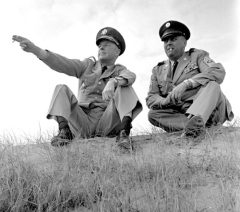From the Stars and Stripes archives
Normandy revisited, 20 years later
20 years later, two D-Day veterans return to Omaha Beach for the first time

View Gallery (5 images)
THE SERGEANT LOOKED to the high ground and remembered the agony.
"They were laying up there with hand grenades, pulling the pins and rolling them down on top of us," he said. "You couldn't see nothing but dead bodies out here."
The colonel peered down the narrow beach and recalled the confusion and jarring noise.
"There was a burned-out half-track there," he said. "I crawled behind it and lay there exhausted. I was there not more than three or four minutes when a shell exploded right behind me. It tore a hole in my coat, but it didn't hit me."
The lapping of the English Channel surf against the sand and stone of the Normandy coast released a swell of frightful memories as two veteran soldiers revisited the strand they assaulted 20 years ago against a desperate defense.
Col James K. Gaynor, now legal advisor at EUCOM Hq near Paris, was an intelligence officer, and Sgt Maj Jack Polnoroff, now topkick of the 2nd Bn, 70th Armor, 24th Inf Div, at Augsburg, Germany, was a machine gun squad leader in the D-Day landing.
Neither had returned to Omaha Beach until they went back this year with a Stars and Stripes reporter and, photographer.
They found it wrapped in silence, washed clean by the waves. They discovered changes. The edge of a cliff has tumbled into the sea. Shifting sand has taken new form during the last two decades.
It took time for them to adjust to the quietness and the cows grazing on the hills above. They used maps to orient themselves and then they remembered.
"We came into this cut and landed just about 1,200 yards east of St. Laurent," Gaynor said. "I was standing right by that bunker at the head of the draw, talking to the chief of staff of the 1st Division."
The masonry bunker is one of many which nestle against the coastline, so heavily constructed that they have remained intact through the years. A rusting barrel still extends through the firing port.
"It looks like an 88 to me," Polnoroff said. "While you were assaulting this one, another gun down the beach was tearing hell out of you."
The trim, gray-haired colonel walked slowly up the draw, his eyes searching for details.
"I'm satisfied this is the Easy-1 exit," he said. "Our first CP was right up there. That field beyond the fence looked big enough for a light plane to land, but one of them tried it and crashed.
"You could look inland and see the town of St. Laurent afire. It burned all night."
Polnoroff was puzzled. He couldn't find the sharp cliff he remembered crouching behind. After a long walk over the hills ascending from the beach, he ran across old trenches.
"This is the area," he yelled. "From here is where they rolled those goodies down on top of us.
"You see those breakers out there. That was the sandbar where our boat was hit. These trenches were much farther back from the edge of the cliff. The whole thing has tumbled in.
"But this is the place. Down there where the base of the cliff used to be is where I had a drink from mamma. Up there on the crest is where we made coffee with Vichy water. There's the draw where Col Mathews was killed."
POLNOROFF is a paunchy man with humor in his eyes. He was talking rapidly now. The years were bridged.
"We landed at H-hour minus 10 minutes. The only thing we had back of us was ships. Destroyers were firing support. They had told us there would be plenty of holes to take cover in, but when we came in there were no holes.
"I was part of M Co, 16th Regt, 1st Inf Div. The weather was clear and the water was rough. It was just turning daylight when we went down the nets into the boats. We rendezvoused and it was daylight when we got in.
"As I was getting into the boat I lit a cigarette. One of the ship's officers screamed, `Get that man's name.' So I said, `What are you going to do to me? I'm already an infantryman making the invasion'.
"Our boat was hit by a mortar shell coming in. It killed a naval officer who was hanging over the bow, directing the coxswain. The ramp fell and the boat was swamped, but it was close against that sandbar.,
"Boy, it was exciting to walk through the water. Your feet were working fast but you were just barely moving, and the machine gun and mortar fire was hitting all around."
Polnoroff remembered that his mother home in Brooklyn had sent him some miniature bottles of brandy and spirits and he had them in his pack.
"When we got up against that cliff, I whipped them out," he said. "There were two wounded lying there and I gave them each one and my buddy got one and there was one for me.
"It tasted good, but you really didn't need it. The adrenalin was pumping through you so fast.
"Later, we went back to the boat and got some equipment we had left there. We were wearing assault vests — like a jacket without any arms. There was a 25-pound TNT charge in the back and we had all kinds of grenades and gear. We had to carry everything for the first two or three days.
"When we were going back to the boat, a round hit a dead man and splattered me with his entrails. Somebody yelled, `Good God! Polnoroff's hit.'
"I felt awful sorry for myself, but I soon found out I wasn't hit at all.
"Capt Kimball Richmond, a company commander, got our battalion organized and started to lead us up the hill. He got a DSC for this, I think. It was a terrific job.
"We had to get off the beach because they were rolling those grenades on us and shooting us up pretty bad. It was a little wet, and going up that cliff was slippery. It took us an hour and a half to get going. Then we went to the top of the hill and started taking trenches and bunkers. We lost a lot of people because the trenches were mined.
"We got inside this German bunker and we wanted to make some coffee, but all we could find was Vichy water. So we dumped it into an old pot and made coffee with it.
"I always thought we hit Omaha Easy Red, but this map shows Fox Green. The 116th Regt was on our right and the British on the left. Our regimental executive officer, Lt Col John H. Mathews, set up a CP in a little shack right in that draw. It was hit immediately and he was killed."
GAYNOR, who was deputy G2 of the V Corps in the landing, also lost his landing craft and had to swim for the beach. His story came out piecemeal as he strolled through the area and mused about the assault.
For tactical reasons, the corps had divided its headquarters into two groups — a forward command post and an alternate group which landed in the afternoon. Gaynor was the alternate intelligence officer aboard the transport Charles Carroll, which carried the alternate headquarters group from England. He came in at 4:35 p.m.
"I was leaning over a rail in the LCI, talking to an officer, when five machine gun bullets ripped through the wall of the landing craft right over our heads. They would have hit us if we hadn't been leaning over. It was the first time I realized we were being shot at."
A hundred yards from shore came the second shock. An artillery shell blasted the landing craft and grounded it, killing one man.
"I had to walk over his body to get out," the colonel said. "The water was deep enough to have to swim and I inflated my life belt. I had an officer and two enlisted men with me and one of the enlisted men drowned."
During the struggle to reach the beach, Gaynor came upon one soldier who was sinking.
"I grabbed him and someone grabbed the other arm and he fought us. The other fellow said, `Let's pin his arms and get him in.' And we did. I don't know who they were."
It was after the swim that Gaynor lay behind a wrecked half-track to rest and was routed by a shell which punctured his coat.
"They were still shelling pretty heavily at this point," he said. "The beach was about 75 yards wide at low tide, but very shortly after I came in it was high tide and all operations ceased because you couldn't see obstacles in the water.
"Everything was still in a state of confusion. I took off up the beach and worked my way to the CP which was inland."
The colonel found the spot where the first-night CP stood. He found a bucolic scene, a group of tethered goats.
"The morning after D-Day, I was standing right there, talking to Ernie Pyle," he said. "It was a pretty noisy first day and there were constant explosions. There was some antiaircraft but it was not very effective.
"At our second CP, we had tents on the high ground over there and slept dug in about 100 yards down the hill. Someone came through the area and yelled, `Gas attack.' We had lost our gas masks in the landing and I knew the high ground was the safest, so I ran up that hill barefoot in about 20 seconds.
"It was a false alarm. We never had gas attacks. Later, it took me an hour and a half to walk barefoot back down that hill."
If one looks closely, he can still see the marks of conflict at Omaha Beach — pieces of rusty shrapnel and barbed wire half buried in the sand, the stumps of poles which once bore dreaded hedgehogs are bared at low tide. The hedgehogs held mines just under the water surface to blow up landing boats.
There is a new paved road which leads along the water's edge from a stone monument to the U.S. 1st Div. The road is lined with summer homes, some of which use old German bunkers for storage. There are beach shacks for bathers. Yellow flowers of the Scotch Bloom family brighten the hills.
Gaynor and Polnoroff went next to the Normandy Cemetery and memorial where lie 9,386 of their fellow invaders in a 170-acre park overlooking the beach from the high ground. The names of another 1,557 whose bodies were never found are inscribed on the curving walls of a Garden of the Missing:
Polnoroff consulted a directory and found the grave of his buddy, S Sgt Thomas F. DeNicola of New York. There he rubbed at a small brown stain on the white cross and blew his nose.
"He was about a foot and a half from me when he got killed," he said. "We ran into a little fire fight. He shot one of them and raised up to say, `I got him.' About that time, they got him too.
"He was in my company and we used to talk about going to South America together when this was all over."
GAYNOR located the grave of his enlisted man who drowned on the way to the beach — Tech 4 Francis M. Cotave Jr. of New Jersey.
"I didn't see him drown but when we got in and checked up, we realized he didn't make it," the colonel said.
Gaynor, 51, calls Greensburg, Ind., home, and takes pride in holding more law degrees than anyone else in the Army. He was a minor league baseball umpire while going to school before World War II. After the war, he won a Regular Army commission and the Army let him finish law school at Indiana University. While assigned to the Pentagon, he went to George Washington University at night and earned master's and doctoral degrees.
He has served in the Judge Advocate General's office, as staff judge advocate in the Ryukyus Comd on Okinawa, and at Ft. Knox, Ky., and as chief legislative director in the office of the Secretary of the Army.
Gaynor has been legal advisor for EUCOM since last July. He has a daughter, Mrs. W. H. Patterson of Greenwood, S. C., and a son, James K. Gaynor Jr., in high school in Paris. He recently became a grandfather when W. H. Patterson III was born.
"I went to Ireland in May of '42 and moved to England in November for the last five months of planning before the invasion," he said. "I made lieutenant colonel about six months before the landing at the age of 31."
"What happened to intelligence, colonel?" Polnoroff asked. "They told us there was only a light force on the beach, but we found a division had come in here."
"Yes, the 326th Div from Germany had been here about a week for maneuvers. We were satisfied they weren't sent here because of the invasion. The militarily sound thing would have been to pull them back and use them for a counterattack. We were lucky to catch them where they were."
"We were supposed to land on the 5th, but the night of the 4th we found new beach obstacles in aerial photos and passed the word."
Polnoroff, 42, has spent half his years in the Army. His father was a soldier in Odessa, Russia. who immigrated to America. Polnoroff followed in his father's footsteps and became a soldier, but his six brothers all were sailors.
He enlisted in the Army a year before Pearl Harbor and when he got out in 1945, he shipped out as a merchant seaman, but reenlisted for the Army life two years later. He has remained a bachelor.
"If the Army wanted me to have a wife, they would issue me one" he said.
Polnoroff served in the Korean War and also in Thailand, Formosa and Quemoy. He wears the Purple Heart with three clusters for wounds received in Africa, Germany and Korea.
He won the Silver Star when he helped break up an enemy attack on his unit's flank in Germany, and also wears the Bronze Star with two clusters.
"I'm one of the few who went all the way from Africa through to the end of the war," he said. "I didn't miss a lick."
He was in England in late 1943.
"At Barnstable, we had a mock-up of a beach and practiced our assault landings. We even had a sandbar like the one at Omaha."
"I designed that mockup," the colonel said.
"Well, we were always having alerts at our home station at Lexington by the Sea, and one day we had an alert, packed our stuff and got up there to the beach and they wouldn't let us out," Polnoroff said.
"We stayed there for two or three days. They issued us French francs and showed us maps of where we would land. At this point, they whipped a British guard around us.
"We came over on a British vessel, the Queen Empress, but the small boats were American-manned. The American ships had what they called an `invasion breakfast' — steak and ice cream at 4 in the morning. But on the British ship we got a quarter cup of coffee and a cold corned beef sandwich.
"Some guys were wearing what they called their lucky underwear. We'd been through three invasions and they still wore the same patched-up drawers. They wouldn't part with them for anything in the world.
"The last day on the ship, we spent playing poker. Little Palindino won all the francs and put them in his pack, but he lost his pack on the beach and never could find it."











